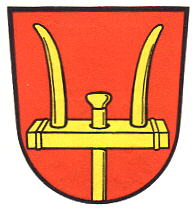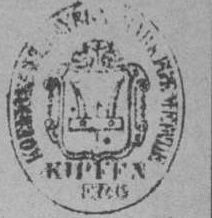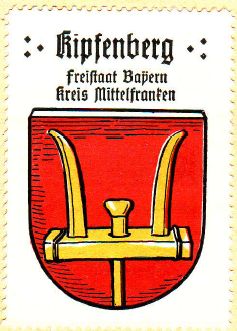Kipfenberg: Difference between revisions
Knorrepoes (talk | contribs) m (Text replacement - "===Official blazon=== *(de) " to "{| class="wikitable" |+Official blazon |- |'''German''' | ") |
Knorrepoes (talk | contribs) m (Text replacement - ". ===Origin/meaning===" to ". |- |'''English''' | {{blazon wanted}} |} ===Origin/meaning=== ") |
||
| Line 14: | Line 14: | ||
| | | | ||
In Rot ein goldener Wagenkipf. | In Rot ein goldener Wagenkipf. | ||
|- | |||
|'''English''' | |||
| {{blazon wanted}} | |||
|} | |||
===Origin/meaning=== | ===Origin/meaning=== | ||
The town of Kipfenberg was a possession of the Eichstätt Abbey, and the Kropf family acted as local vassals for the abbots. The family named itself Lords of Kipfenberg and adopted a canting element as their arms, a Wagenkipf (a part of a carriage). This symbol also appears on the seals of the town around 1400. All later seals and arms all used this typical symbol, sometimes with an additional tower as a symbol for the city. | The town of Kipfenberg was a possession of the Eichstätt Abbey, and the Kropf family acted as local vassals for the abbots. The family named itself Lords of Kipfenberg and adopted a canting element as their arms, a Wagenkipf (a part of a carriage). This symbol also appears on the seals of the town around 1400. All later seals and arms all used this typical symbol, sometimes with an additional tower as a symbol for the city. | ||
Revision as of 08:07, 5 July 2022
This page is part of the German heraldry portal Deutsche Wappensammlung |
Heraldry of the World |
|
German heraldry:
|
Selected collector's items from Germany:
|
KIPFENBERG
State : Bayern
District (Kreis) : Eichstätt
Additions : 1971 Arnsberg, Attenzell, Biberg, Böhming, Buch, Grösdorf, Irlahüll; 1972 Dunsdorf, Hirnstetten, Oberemmendorf, Pfahldorf; 1974 Schelldorf
| German |
In Rot ein goldener Wagenkipf. |
| English | No blazon/translation known. Please click here to send your (heraldic !) blazon or translation |
Origin/meaning
The town of Kipfenberg was a possession of the Eichstätt Abbey, and the Kropf family acted as local vassals for the abbots. The family named itself Lords of Kipfenberg and adopted a canting element as their arms, a Wagenkipf (a part of a carriage). This symbol also appears on the seals of the town around 1400. All later seals and arms all used this typical symbol, sometimes with an additional tower as a symbol for the city.
| The municipal stamp shown in 1892 |
The arms by Hupp in the Kaffee Hag albums +/- 1925 |
Contact and Support
Partners:
Your logo here ?
Contact us
© since 1995, Heraldry of the World, Ralf Hartemink 
Index of the site
Literature : Stadler, 1964-1971, 8 volumes.














